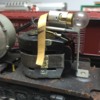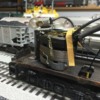I recently purchased a postwar Lionel 2321, and was surprised to find these strips of paper glued over the motors. Could someone please shed some light on what the purpose of these strips are?
I was so intrigued that I joined the forum to learn more. I'm intending this C7 unit to be a runner, and hate to have to rip this off if it's factory applied but it seems inevitable! I'll be regularly cleaning the commutators so not planning to glue these back unless absolutely necessary. My only guess is that it holds the wires away from the headlight bracket but it seems like a bootleg detail on an otherwise beautiful motor. Maybe Lionel needed a quick fix?












